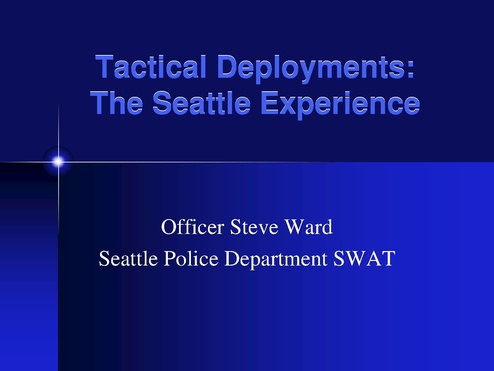Taser Seattle Pd Tactical Deployments Ppt
Download original document:

Document text

Document text
This text is machine-read, and may contain errors. Check the original document to verify accuracy.
Tactical Deployments: The Seattle Experience Officer Steve Ward Seattle Police Department SWAT Outline • • • • Review of Seattle’s one year report Seattle’s high profile cases Analyzing M26 deployment evidence M26 testing Seattle P.D. One Year Report • One year study from 1-1-01 through 1-1-02 • 106 M26 incidents studied • Some incidents involved more than one deployment • All 106 taser incident reports were reviewed and the information was recorded Taser Use By Time Of Day 60 50 40 Percent Number 30 20 10 0 0800-1600 1600-2400 2400-0800 Incidents By Taser Officer, Back-up, Or Requested 60 50 40 Taser Officer Back-up Request 30 20 10 0 Number of Incidents Percent of Incidents Initial Classification Of Incidents 16% 16% 13% Drug/Alcohol Related Fight/Disturbance 16% Mental Illness/Suicide Traffic Related Violent Crime 19% Other 20% Age Of Suspects 20 18 16 14 12 Number of Subjects Percent of Subjects 10 8 6 4 2 0 <20 21-25 26-30 31-35 36-40 >40 Race Of Subjects 6% 4% White African American 48% 42% Asian/Pacific Islander Other Taser Subject Impairment 23% Alcohol impaired 40% 10% 4% 23% Chemical/Drug impaired Drug & Alcohol impaired Mental illness/delusional No apparent impairment Suspect Injury • 13 percent of suspects were injured subsequent to taser deployment - generally occurred as suspects fell to the ground • No suspect injuries were major • No injuries were attributed to the M26 itself Officer Injury • In 5 percent of the deployments an officer was injured • All injuries were minor Taser Use Against Armed Suspects • 25 percent (26 cases) of all M26 applications were against armed suspects • 11 of the 26 suspects were armed with knives • 62 percent of armed suspects were impaired • These statistics show the need to deploy with lethal cover Taser Performance • Out of all the deployments there have been 14 cases of misses or clothing related failure • In 95 percent of deployments there was a reported disabling or partially disabling effect on the suspect • In 92 percent of deployments the taser was solely credited with bringing the situation to resolution Seattle High Profile Cases Seattle High Profile Incidents Case 1 • • • • Knife wielding suspect Small room 2 M26 deployments 1st deployment made contact but was broken • 2nd deployment - no verifiable contact • Suspect lunged and cut officer’s shirt • Lethal cover shot suspect Seattle High Profile Incidents Case 2 • • • • • Sword wielding suspect 2 M26 deployments 1st deployment was a miss 2nd deployment was effective Lethal cover acted at same time to protect themselves and other officers Analyzing The Evidence • Taser instructors might get called to assist in analyzing evidence from a taser deployment • The need to analyze evidence supports the idea of saving the cartridge, wires, and probes after a deployment Analyzing The Evidence • If possible, talk to the officers involved to get their thoughts about the incident • Read all statements and reports from the incident • View the physical evidence - clothing, pictures, M26 cartridge, and the M26 Clothing Evidence TASER PROBES Forensic Mannequin Analyzing The Evidence: Misses Conclusion? Miss Hit Analyzing The Evidence: Misses Cartridge Analysis Both probes attached (Grass) Analyzing The Evidence: No Contact With Body • Examine the body or pictures of the suspect for M26 puncture wounds • Ask officers if they heard the M26 deploy - a loud deployment usually means no contact was made Probe impact 10” Analyzing The Evidence: No Contact With Body • Examine the body or pictures of the suspect for red or sunburned areas around the area where the dart came close to the skin Wounds Taser Testing • Department administration might want to have independent testing done • RCMP published an independent report in May of 2001 • Washington State Patrol Crime Lab has commissioned a study and is writing a report for the Seattle Police Department Contact Information • • • • Officer Steve Ward Seattle Police Department SWAT 610 3 Av Seattle, WA 98104 206-856-5868 • Tasertrainer@hotmail.com • Homepage.mac.com/stevenward • Password “buffalo”




